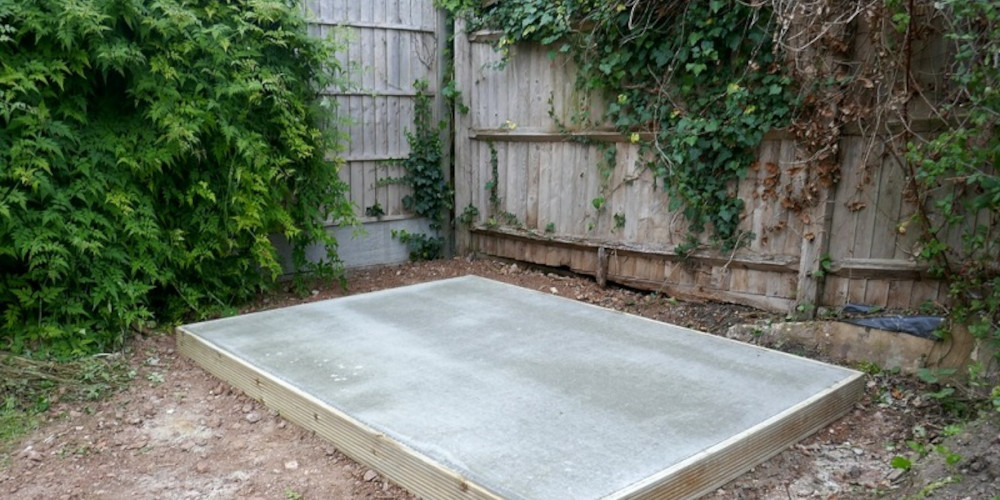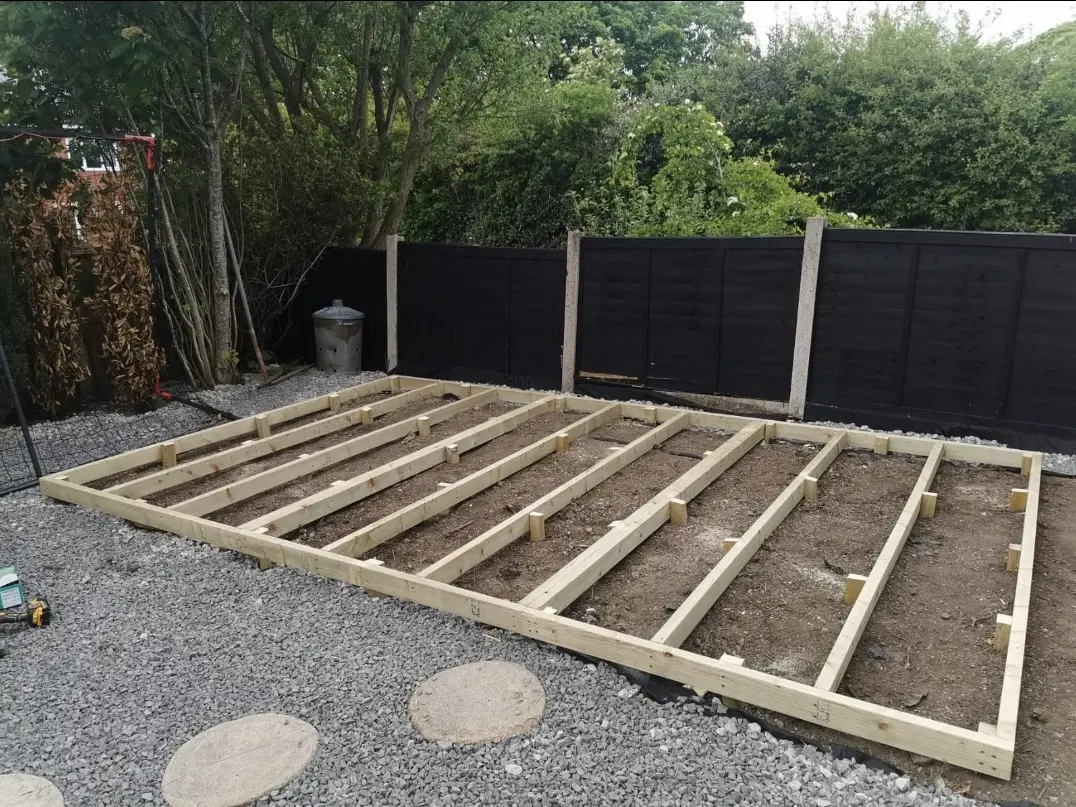
Concrete bases form the foundation of countless garden and landscaping projects — from sheds and summerhouses to patios and extensions. In this post, we take you behind the scenes at Plex to show how our teams prepare, pour, and finish professional concrete bases across Worcestershire. You’ll learn what really goes into the groundwork, why precision is essential, and how a well-built base ensures long-term stability for any outdoor structure.
See how we can help you!
Concrete bases are the unsung heroes of landscaping. They provide the structural integrity for everything from greenhouses and pergolas to workshops and garden rooms. In Worcestershire, where ground conditions range from clay-heavy soil in Droitwich to sandy loam in Evesham, a uniform approach doesn’t work — every site needs its own preparation strategy.
A DIY concrete base might seem simple, but without correct sub-base compaction, formwork, or curing, cracks can appear within months. A professionally installed base ensures uniform strength, proper drainage, and a level surface that lasts decades without movement.
Our process begins with a detailed site assessment. We check for slopes, drainage patterns, and ground stability. In Worcester, for example, many gardens naturally slope away from the property, requiring ground levelling or minor excavation.
We then mark out the area precisely using string lines and stakes, ensuring the base aligns perfectly with the intended structure. The next step is excavation — typically 150–250mm deep, depending on the project’s load requirements. Soft spots are removed, and the surface is levelled to create a stable foundation.
The sub-base is the layer that absorbs weight and prevents the concrete from cracking or sinking. We use MOT Type 1 crushed stone, compacted in layers using a vibrating plate compactor. This step is critical — the sub-base must be firm enough that no footprints are left when walked on.
In wetter Worcestershire areas such as Pershore or Malvern, we sometimes incorporate a layer of free-draining hardcore beneath the sub-base to improve water management and prevent frost-related movement.
Once the sub-base is ready, we install formwork — strong timber or steel boards that outline the base’s shape and height. This ensures the concrete holds its shape during pouring and curing.
We use laser levels and spirit levels to set the top edge of the formwork to the exact finished height, guaranteeing the surface will be perfectly flat or sloped as required for drainage.
For large projects like garage bases or garden rooms, expansion joints are planned to allow controlled movement as the concrete cures.
Reinforcement is essential for concrete bases supporting heavy loads or structures. Depending on the project, we use steel mesh (A142 or A193) or rebar grids placed on small spacers to sit within the middle of the concrete layer.
This reinforcement prevents cracking and helps distribute weight evenly across the slab. In areas like Kidderminster, where ground moisture fluctuates seasonally, reinforced concrete provides long-term durability.
We typically use C25 to C35 grade concrete, depending on project demands. This mix ensures optimal strength for domestic and light commercial applications. Concrete can be mixed on-site for smaller projects or delivered ready-mixed for larger installations.
During the pour, the concrete is spread evenly across the formwork and vibrated or tamped to remove air pockets. This process, known as compaction, is key to eliminating weak points. Our teams then screed the surface to create a perfectly smooth and level finish.
After levelling, the surface is finished to suit its purpose — from a smooth trowelled finish for patios to a textured or brushed finish for non-slip workshop floors.
The curing process begins immediately. We protect the slab from direct sun, frost, or heavy rain using curing blankets or plastic sheeting. Concrete continues to strengthen over several days — reaching around 70% of its full strength within the first week.
For precision work, Plex often revisits the site after curing to check for settlement, ensuring the surface remains completely level and ready for installation of garden buildings or paving.
Drainage around the base is just as important as the slab itself. We create slight perimeter falls or install soakaways where required to prevent water collecting around the edges. This protects the concrete from erosion and frost damage over time.
Perimeter edging or brick courses are also added at this stage if the structure design calls for raised foundations or decorative borders.

A neglected garden reimagined into a stunning rustic retreat, featuring reclaimed brickwork, a charming patio, and vibrant planting—blending timeless character with thoughtful design.

A complete garden overhaul in Cheltenham, transforming an overgrown, rat-infested space into a sleek, low-maintenance outdoor oasis with porcelain paving, integrated lighting, and a rat-proof brick wall.
Building on Worcestershire soil requires a deep understanding of how moisture and temperature affect stability. In clay-heavy areas, a concrete base must be thicker and better drained to prevent expansion cracking. In sandy soils, proper compaction and reinforcement are vital.
Because Plex works across Worcester, Pershore, and Malvern, we know how to adapt to local conditions — ensuring every base we install stands the test of time.
Every Plex project complies with British Standards for concrete works (BS EN 206). From PPE and equipment safety to mix ratios and curing times, our teams follow precise procedures.
According to Concrete Centre UK, achieving long-term durability depends on correct curing and reinforcement — factors that can’t be left to chance. That’s why professional installation is the only way to guarantee performance.
1. Strong foundations mean lasting results.
A properly built concrete base ensures stability and prevents cracking or sinking, even after years of use.
2. Sub-base compaction is essential.
Without a solid, compacted foundation layer, concrete can settle unevenly or fail under weight.
3. Reinforcement prevents cracking.
Steel mesh or rebar adds crucial tensile strength, especially for heavy structures like workshops or garages.
4. Local conditions affect performance.
Clay and sandy soils require different construction methods — local expertise ensures long-term durability.
5. Professional curing makes all the difference.
Concrete must be protected as it hardens; rushing this step leads to weak, brittle slabs.

.webp)
.webp)
.webp)
.webp)
.webp)
.webp)
.webp)
.webp)
Concrete bases are not one-size-fits-all — the right specification depends on the structure they’ll support.
For garden sheds and greenhouses, a 100mm reinforced slab is typically sufficient. These bases prioritise smoothness and level accuracy to ensure doors align correctly and structures sit flush.
Workshops and garages, on the other hand, require thicker bases — often 150–200mm — reinforced with heavy-duty rebar to handle vehicle or machinery loads. Drainage channels are sometimes added to manage water run-off from equipment cleaning or rain.
For patio or pergola bases, the focus is on aesthetics and water flow. Here, the concrete may be part of a layered system — forming the hidden strength beneath decorative paving or stonework.
Some homeowners in Worcestershire also request floating concrete bases for garden rooms, designed to support insulated timber structures while reducing ground moisture transfer.
Each type demands a slightly different technique, but all rely on the same principles: level preparation, proper reinforcement, and slow, consistent curing. Whether you’re building a summerhouse in Malvern or a new storage unit in Worcester, the success of your project begins — and ends — with the base.

Building a concrete base is far more than just pouring and smoothing. It’s an exacting process that demands precision, local knowledge, and experience. At Plex, every base we install represents structural reliability, whether for a garden building, extension, or outdoor living area. From soil preparation to reinforcement and finishing, we take pride in doing the unseen work that guarantees visible results. Because when the groundwork is right, everything built above it stands strong — season after season, year after year.

Retaining walls are more than just garden features — they’re structural systems that hold back soil, prevent erosion, and shape multi-level outdoor spaces. In this post, we take you behind the scenes at Plex to show how our team designs and builds retaining walls that stand strong through Worcestershire’s changing seasons. Learn what materials, drainage systems, and engineering techniques ensure every wall looks beautiful and lasts for decades.

Concrete bases form the foundation of countless garden and landscaping projects — from sheds and summerhouses to patios and extensions. In this post, we take you behind the scenes at Plex to show how our teams prepare, pour, and finish professional concrete bases across Worcestershire. You’ll learn what really goes into the groundwork, why precision is essential, and how a well-built base ensures long-term stability for any outdoor structure.
.webp)
Ever wondered what really goes into preparing a professional patio or garden path? In this post, we take you behind the scenes at Plex to show the full process — from excavation to sub-base compaction — that ensures every surface stays level, strong, and long-lasting. Learn the science, precision, and materials that make the difference between a short-lived patio and one that lasts decades.